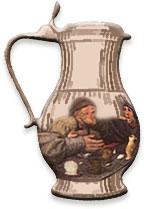|
Viticulture has always
been associated with the Land of Israel. In the early centuries of the
common era, there is special mention of Sharon wine, Carmel wine, and
the potent variety called Ammon wine. Later during the Byzantine period,
we find wine from the Land of Israel reaching distant parts of the Western
Roman Empire, as far as Gaul. In Egypt, it was regarded as a gourmet product,
fit for the tables of the rich. Such wines were often named after the
port city they were shipped from, such as the Wine of Ascalon or Wine
of Gaza. There is no reason to doubt that this was the situation in preceding
centuries as well.
A word should be said about
the mention of "Wine of Italy" (yayin ha-italki) in tannaic
literature. The term is puzzling, because the growth of the Empire was accompanied
by the disappearance of Italian wines from the market. They could not compete
with wine from the conquered provinces. The Roman Emperor Domitian[1]
tried to protect the Roman product by means of preferential decrees, but it
did no good. How then did Italian wine get into the Mishnah?[2]

A
quarter-log of Italian wine can make one drunk (TB Eruvin 64B)
 The
answer is that it never really did. The phrase "yayyin ha-italki"
(Italian wine) always appears in a quantitative context, such as one log
or a quarter-log and grew out of a misreading of words which originally
had nothing to do with Italian wine. The important manuscript versions read
"be-italki" — by Italian measure. The
answer is that it never really did. The phrase "yayyin ha-italki"
(Italian wine) always appears in a quantitative context, such as one log
or a quarter-log and grew out of a misreading of words which originally
had nothing to do with Italian wine. The important manuscript versions read
"be-italki" — by Italian measure.
It therefore appears
that this phrase, restored to its proper meaning by the correction of a single
Hebrew letter, has no connection with foreign trade, since it does not refer
to a kind of wine, but to a kind of liquid measure. "Log yayyin be'italki"
yields the meaning: "one Italian measure of wine." The whole matter
is connected with the penetration of the Roman system of weights and measures
into the Middle East.
The notion that wine
was imported into Palestine from Silicia is based on a misunderstanding
of the following tradition:
Rabban Simeon ben Gamliel
said: I myself once saw Rabbi Simeon Ben Kahana (i.e., a priest) drinking terumah
(heave-offering) wine in Akko. He told me: "This wine came to be from Sicilia."[3]
It should be understood
that this passage has no connection with trade or commerce. It is simply
a case of the laws of terumah (heave-offering) being observed in
the Second Temple period by Jews from the Diaspora. They would bring their
offerings to the Holy Land and present them to a priest. Later, halakhic
ruling dispensed with this practice and, undoubtedly, put an end to such
"imports."
[See also rabbinic
attitudes towards wine drinking]
|
[1]
For information on wine in ancient Rome: http://www.ancientsites.com
[back]
[2]
TB
Sanhedrin 8:2. [back]
[3] Tos. Shevi V:2; TJ Hal 4:60b. [back]
|
|
 With
permission, from: Gedaliah Alon, The Jews in their Land in the
Talmudic Age (translated and edited by Gershon Levi) pages 164-66,
Magnes Press, The Hebrew University, 1980, 1984, 1996 With
permission, from: Gedaliah Alon, The Jews in their Land in the
Talmudic Age (translated and edited by Gershon Levi) pages 164-66,
Magnes Press, The Hebrew University, 1980, 1984, 1996 |
|